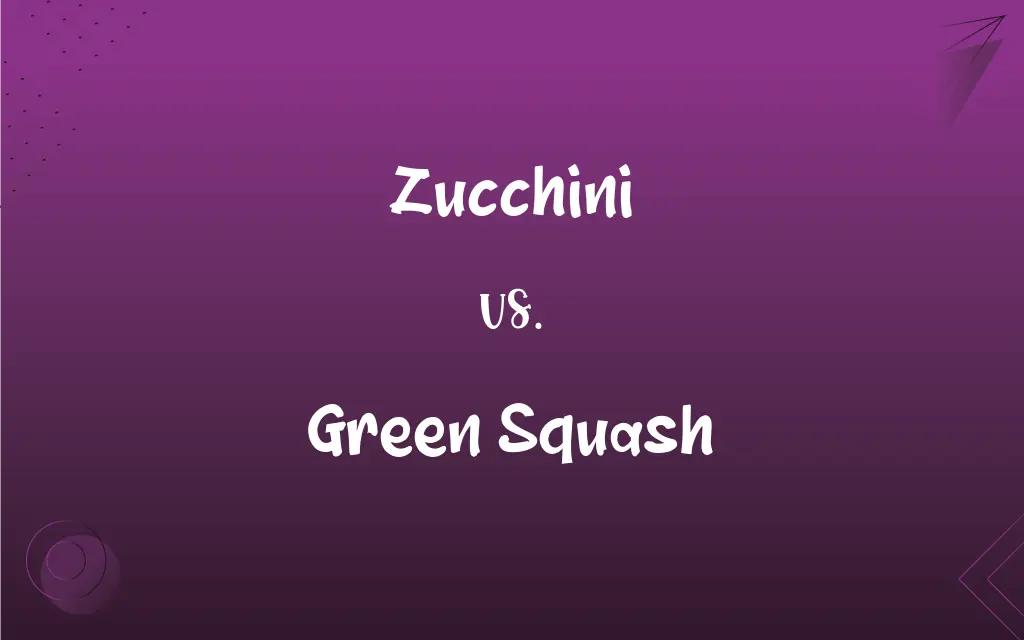Zucchini vs. Green Squash: What's the Difference?
Edited by Janet White || By Harlon Moss || Updated on October 28, 2023
Zucchini is a type of green squash; both refer to a summer squash that is usually green but can come in other colors.

Key Differences
Zucchini is a specific variety of summer squash known for its elongated shape and usually dark green skin. On the other hand, green squash is a broader term that can encompass various green-colored squashes, including zucchini.
The term zucchini is predominantly used in American English and is derived from Italian. Green squash, as a descriptor, is more generic and simply indicates the color of the squash without specifying the variety.
While zucchini is favored in many culinary dishes for its tender flesh and mild flavor, green squash can refer to various squashes, each with its unique taste and texture, although the differences might be subtle.
When shopping for vegetables, you might specifically see labels for zucchini due to its popularity, while other types of green squash may be labeled more generically or by other specific variety names.
Both zucchini and other types of green squash are versatile in cooking. They can be grilled, roasted, sautéed, or even eaten raw. However, the specific variety of green squash might determine its best use in certain dishes.
ADVERTISEMENT
Comparison Chart
Definition
A specific variety of summer squash
A term for any green-colored summer squash
Origin of Term
Derived from Italian
Descriptive term based on color
Shape
Typically elongated
Can vary depending on the specific variety
Common Use in Cuisine
Widely used in various dishes, from grilling to baking
Usage might depend on the specific variety
Popularity in Naming
Commonly labeled in grocery stores
May be labeled generically or by variety name
ADVERTISEMENT
Zucchini and Green Squash Definitions
Zucchini
Zucchini originates from the Americas but is popular worldwide.
In Italy, they often use zucchini in pasta dishes.
Green Squash
Green squash is typically harvested before fully maturing.
Young green squash has a tender texture.
Zucchini
Zucchini is a dark green, elongated summer squash.
I added some sliced zucchini to the stir-fry.
Green Squash
Green squash is a summer squash with a green exterior.
I picked some fresh green squash from my garden.
Zucchini
Zucchini can be eaten both raw or cooked.
I like adding raw zucchini ribbons to my salads.
Green Squash
Green squash has a versatile use in cooking.
I roasted green squash with some olive oil and herbs.
Zucchini
Zucchini is known for its mild flavor and tender flesh.
Zucchini bread is a tasty way to use this vegetable in baking.
Green Squash
Green squash can refer to various varieties, including zucchini.
The grocery store had several types of green squash available.
Zucchini
Zucchini flowers, or blossoms, are also edible.
Stuffed zucchini blossoms are a delicious delicacy.
Green Squash
Green squash can be found in different shapes and sizes.
This variety of green squash is rounder than zucchini.
Zucchini
A variety of summer squash (Cucurbita pepo) having an elongated shape and a smooth, thin, dark green rind.
Zucchini
A courgette; a variety of squash, Cucurbita pepo, which bears edible fruit.
Zucchini
The edible fruit of this variety of squash.
Zucchini
Marrow squash plant whose fruit are eaten when small
Zucchini
Small cucumber-shaped vegetable marrow; typically dark green
FAQs
Is zucchini a type of green squash?
Yes, zucchini is a type of green squash.
Are there other colors of zucchini?
While green is the most common, zucchini can also be yellow or have a striped pattern.
What is green squash?
Green squash refers to any summer squash that is green in color, including zucchini.
Are zucchini and green squash fruits or vegetables?
Botanically speaking, they are fruits, but in culinary terms, they are treated as vegetables.
Can green squash be eaten raw?
Yes, both zucchini and other green squashes can be eaten raw, often in salads.
How do zucchini and green squash grow?
They grow on low-lying plants and are typically harvested before they fully mature.
Are the flowers of the zucchini plant edible?
Yes, zucchini blossoms are edible and are often used in gourmet dishes.
Can you eat the skin of zucchini and green squash?
Yes, the skin of both is edible and is often left on when cooking.
Are there nutritional differences between zucchini and other green squashes?
The nutritional content might vary slightly, but generally, they are low in calories and rich in vitamins.
Can you grill green squash?
Yes, both zucchini and other green squashes can be grilled.
How can you tell if a green squash is ripe?
A ripe green squash will be firm with a glossy skin and free of blemishes.
Can you spiralize zucchini and green squash?
Yes, zucchini, in particular, is often spiralized to make "zoodles," or zucchini noodles.
Can green squash be used interchangeably with zucchini in recipes?
Generally, yes, but there might be slight differences in texture and taste.
How do you store zucchini and green squash?
Both should be stored in the refrigerator in a perforated plastic bag.
How long does zucchini last after being harvested?
When stored correctly, zucchini can last for about one week in the refrigerator.
What's the best way to cook green squash?
Green squash, including zucchini, can be grilled, roasted, sautéed, or steamed.
What is zucchini?
Zucchini is a specific variety of summer squash, usually with a dark green skin.
Where does the name "zucchini" come from?
It's derived from the Italian word "zucchino," meaning a small squash.
Are zucchini and cucumbers the same?
No, while they look similar, zucchini is a type of squash, while cucumbers are a different vegetable.
What are the health benefits of eating zucchini?
Zucchini is rich in vitamins, minerals, and antioxidants, and it's also low in calories.
About Author
Written by
Harlon MossHarlon is a seasoned quality moderator and accomplished content writer for Difference Wiki. An alumnus of the prestigious University of California, he earned his degree in Computer Science. Leveraging his academic background, Harlon brings a meticulous and informed perspective to his work, ensuring content accuracy and excellence.
Edited by
Janet WhiteJanet White has been an esteemed writer and blogger for Difference Wiki. Holding a Master's degree in Science and Medical Journalism from the prestigious Boston University, she has consistently demonstrated her expertise and passion for her field. When she's not immersed in her work, Janet relishes her time exercising, delving into a good book, and cherishing moments with friends and family.































































